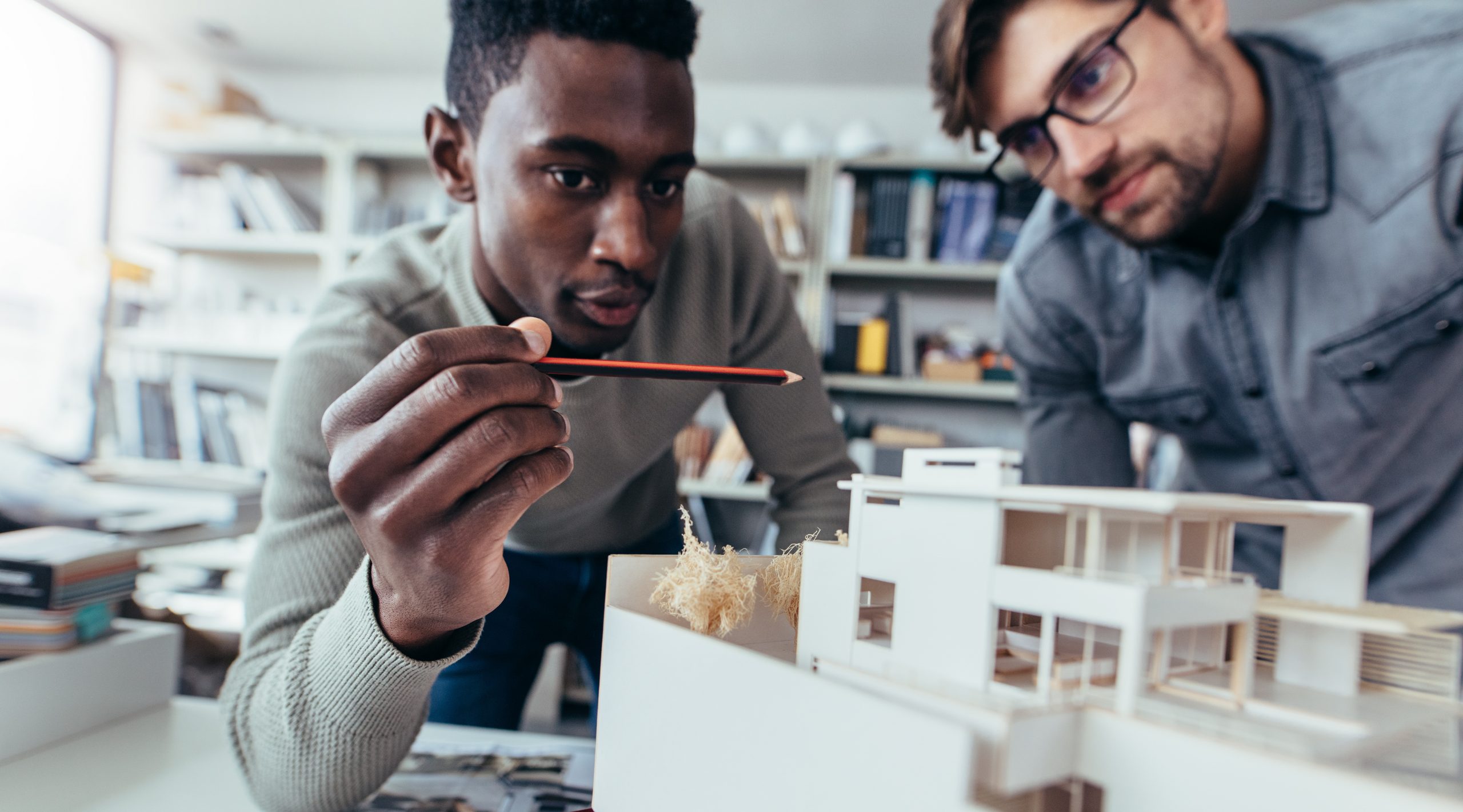Architect Guide to Eco-Friendly Building Materials
Architect Guide to Eco-Friendly Building Materials
Blog Article
Recognizing the Diverse Occupation Paths Available for Aspiring Architect
As an ambitious Architect, you have a globe of profession courses waiting for you. Each course offers one-of-a-kind obstacles and possibilities to use your creative thinking and technical know-how. Whether you're attracted to typical architecture or the nuances of sustainable design, there's a specific niche that lines up with your passions. Understanding these varied options can shape your expert trip, but which instructions will you pick to check out first?
Typical Architecture: Creating Structures and buildings
Standard style focuses on developing buildings and structures that blend performance with aesthetic allure. Your designs can mirror cultural heritage, showcasing regional customs while satisfying modern demands.
You'll establish abilities in preparing, model-making, and website evaluation, permitting you to visualize and communicate your concepts successfully. Involving with clients, you'll require to recognize their vision and translate it into possible layouts.
In addition, developing codes and sustainability practices are vital in your job, ensuring your structures are environmentally pleasant and secure. As you expand in your profession, you'll find chances in residential, industrial, or even reconstruction jobs, each offering special difficulties. Accepting typical architecture leads the way for a fulfilling occupation that admires the past while forming the future.
Urban Preparation: Shaping Communities and Public Spaces
As an aspiring Architect, you can play an important function as a city coordinator, transforming exactly how communities interact and operate. By employing community interaction methods, you'll ensure that locals have a voice fit their atmosphere. Plus, incorporating sustainable layout principles will certainly aid develop rooms that not only meet today's requirements but additionally secure the future.
Function of Urban Planners
While many might think of designers as the single visionaries behind structures, metropolitan planners play a vital function in shaping the more comprehensive landscape of neighborhoods and public spaces. By collaborating with various stakeholders, you'll help make parks, transport systems, and residential areas that advertise social interaction and ease of access. Your expertise in spatial style and community dynamics allows you to picture future growth while protecting social heritage.
Community Engagement Approaches
Reliable neighborhood interaction techniques are crucial for city coordinators to assure that the voices of citizens are listened to and valued in the planning procedure. To cultivate purposeful discussion, you need to prioritize open online forums and workshops where community members can share their concepts and issues. By actively including and paying attention comments, you'll create areas that reflect the area's requirements, ultimately leading to more effective and sustainable metropolitan settings.
Lasting Style Principles
When creating city areas, integrating sustainable design concepts is important for creating environments that grow both environmentally and socially. Think about incorporating environment-friendly spaces, like parks and yards, to boost biodiversity and improve air top quality.
Creating with water conservation in mind is additionally vital-- consider rain yards and absorptive surfaces to manage stormwater. Including community participants throughout the planning process guarantees that the spaces you develop fulfill their demands and encourage social interaction. By accepting these concepts, you'll add to vivid, sustainable urban landscapes that profit every person.

Landscape Design: Producing Lasting Outside Atmospheres
As you explore landscape style, you'll find important style concepts that produce functional and attractive outdoor areas. Lasting practices play a vital role in guaranteeing these settings thrive while reducing ecological influence. And also, you'll discover a variety of occupation opportunities that enable you to make a real distinction in just how individuals interact with nature.
Style Concepts in Landscape
Recognizing design concepts in landscape design is necessary for producing sustainable exterior environments that integrate with nature. You'll need to consider elements like proportion, scale, and equilibrium to guarantee your styles really feel cohesive and inviting. Furthermore, pay attention to seasonal adjustments, developing with products that match the surroundings year-round.
Lasting Practices Summary
Lasting practices in landscape architecture not only concentrate on visual appeals but additionally prioritize environmental health and wellness and source conservation. By integrating indigenous plants, you improve biodiversity and lower the need for chemical fertilizers and pesticides. Applying effective irrigation systems aids save water and minimizes runoff, protecting nearby ecosystems. You can design rooms that advertise soil health, such as exercising and using organic products permaculture principles. Additionally, including eco-friendly framework, like rain gardens and permeable pavements, aids in stormwater administration and reduces metropolitan heat. You add to a healthier world and supply rooms that promote community connection when you create outdoor settings with sustainability in mind. Inevitably, these methods assure your designs profit both individuals and the atmosphere for years to come.
Occupation Opportunities Expedition
With a strong foundation in sustainable methods, landscape architecture supplies a range of job paths that allow you to make a purposeful influence on the atmosphere. Urban organizers typically team up with landscape architects to create eco-friendly rooms in city setups, improving city livability. If you're enthusiastic regarding education and learning, check out here consider ending up being a landscape style instructor, inspiring future generations.
Sustainable Style: Concentrating on Eco-Friendly Practices
As you discover your job in style, embracing eco-friendly methods can establish you apart in a competitive field. Sustainable design focuses on creating structures that decrease environmental influence while improving resident wellness. By incorporating eco-friendly materials, energy-efficient systems, and lasting structure strategies, you'll add to a greener future.
Beginning by getting knowledge of environment-friendly certifications like LEED or BREEAM, which can strengthen your qualifications. Think about how natural light, air flow, and thermal effectiveness can maximize layout. Work together with engineers and ecological experts to introduce remedies index that minimize waste and save sources.
Don't neglect the relevance of neighborhood participation-- appealing local stakeholders can motivate designs that harmonize with the atmosphere. As clients increasingly focus on sustainability, your experience in environmentally friendly techniques will certainly not just attract tasks yet also accomplish your enthusiasm for responsible style. Welcome this vital aspect of the occupation, and enjoy your occupation grow.
Historic Conservation: Protecting and Bring Back Social Heritage
While you commence on your building trip, consider the crucial duty of historic preservation in keeping our social heritage. This area concentrates on the defense and reconstruction of considerable structures, sites, and frameworks that inform the stories of our past. By taking part in historic conservation, you'll assist guard the building tradition that forms community identity.
As a historical preservation Architect, you'll analyze historic importance and evaluate the problem of frameworks. You'll function closely with chroniclers and conservationists to guarantee genuine reconstruction techniques are utilized. This profession course allows you to blend creative thinking with research, allowing you to develop solutions that appreciate original materials and workmanship.
Your job not just adds to sustainability by reusing existing structures yet also cultivates a feeling of satisfaction within areas. Welcoming this path will certainly help you come to be a guardian of background, maintaining the stories and visual appeals that improve our lives.
Inside Style: Enhancing Indoor Spaces
Historic conservation and interior design both share a dedication to boosting the built setting, yet they concentrate on different facets. While historical preservation emphasizes maintaining a structure's cultural and historic worth, indoor architecture absolutely nos in on optimizing indoor rooms for performance and aesthetics.
As an ambitious Architect, you'll discover that interior design permits you to mix imagination with technical abilities. You'll make areas that not just look excellent yet additionally promote convenience and performance. This field entails understanding exactly how light, shade, and materials interact within a room, impacting state of mind and use.
You'll work with numerous projects, from domestic homes to industrial workplaces, making sure that each environment satisfies the requirements of its residents. By focusing on individual experience, you can transform interiors into functional and motivating areas, making a significant influence on how people communicate with their environments. Accept the chance to enhance indoor settings and form the way people function and live.
Industrial Design: Merging Performance With Aesthetics
Commercial design plays an essential duty in producing items that effortlessly blend looks with functionality, making certain that what you use everyday is not just visually appealing however also useful. As an ambitious Architect, you can involve yourself in this field, concentrating on designing every little thing from furnishings to customer electronic devices. Your work includes understanding customer requirements, products, and making processes, allowing you to create ingenious services that enhance day-to-day experiences.
In industrial style, you'll typically team up with manufacturers, marketing professionals, and designers, guaranteeing that your designs are not only stunning but likewise possible. You'll find out to stabilize type and function, prioritizing usability without giving up design. By developing your skills in laying out, 3D modeling, and prototyping, you'll be well-equipped to bring your check ideas to life. This profession course offers a dynamic atmosphere where creativity meets functionality, making it a gratifying selection for designers thinking about shaping the items of tomorrow.
Frequently Asked Inquiries
What Educational Qualifications Do I Required to Become an Architect?
To come to be an architect, you'll need an expert level in design, commonly a Bachelor's or Master's. In addition, you'll need to finish a teaching fellowship and pass the Architect Registration Evaluation to practice legitimately.
Are There Certification Requirements for Various Architectural Occupation Paths?
Yes, there're qualification needs for different building paths. Architect. You'll need to pass exams, full internships, and occasionally seek specialized training, depending on your selected focus, like landscape style, urban style, or historic preservation
What Software Skills Are Necessary for Engineers Today?

How Can I Gain Practical Experience While Examining Style?
You can gain useful experience by interning at building companies, taking part in design competitions, offering for area jobs, or working together with schoolmates on real-world jobs. These possibilities boost your abilities and develop valuable links in the sector.
What Task Opportunities Exist Outdoors Standard Style Firms?
You can explore numerous task opportunities outside traditional design companies, like urban planning, interior style, landscape design, building and construction management, realty advancement, or perhaps roles in sustainability consulting. Each offers special difficulties and incentives.
Whether you're attracted to traditional architecture or the nuances of sustainable style, there's a particular niche that aligns with your interests.When developing city areas, including lasting style concepts is vital for creating environments that flourish both ecologically and socially.As you discover landscape style, you'll discover vital layout principles that create lovely and useful exterior rooms.Understanding design concepts in landscape architecture is crucial for creating sustainable exterior atmospheres that balance with nature.In industrial design, you'll commonly team up with suppliers, marketing experts, and designers, ensuring that your layouts are not only attractive yet additionally viable.
Report this page